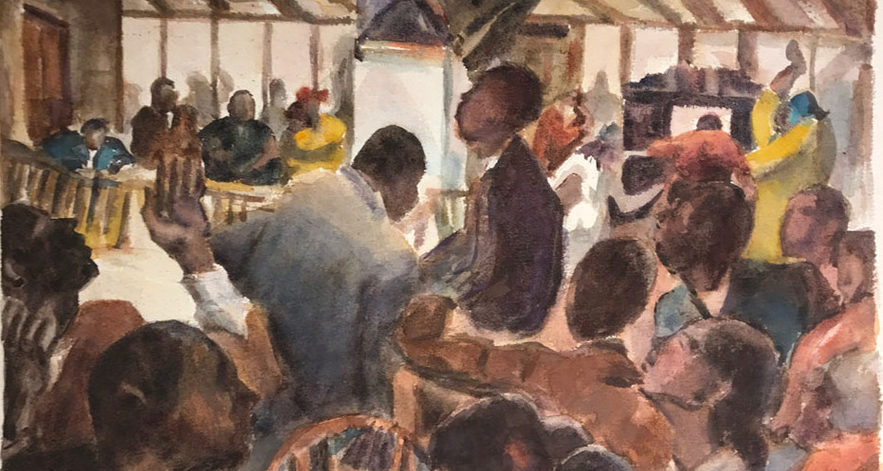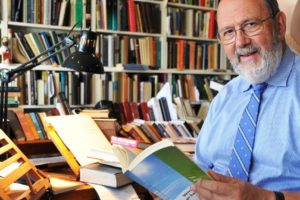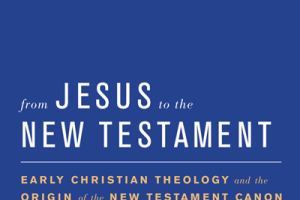In the Gospel According to St. Mark, Jesus introduces and institutes the Eucharist Feast in very few words:
And as they were eating, he took bread, and after blessing it broke it and gave it to them, and said, “Take, this is my body.” And he took a cup, and when he had given thanks he gave it to them, and they all drank of it. And he said to them, “This is my blood of the covenant, which is poured out for many. Truly, I say to you, I will not drink again of the fruit of the vine until that day when I drink it new in the kingdom of God.” (14:22-25)
The purpose of this blog series is to point to the literary structure and devices which Mark uses and demonstrate their interpretive import, or theological significance, when applied to the passage in view. Each post will trace one of three themes in Mark and demonstrate their point of convergence in the passage above. Put another way, I will reflect on three themes in Mark that are big enough that the reader can use this reflection to see the ways in which every single passage in Mark 1-14 sets up the institution of the Eucharist Feast.
Breaking Bread & Bringing Sight to the Blind
Jesus institutes the Eucharist in order to heal his disciples of their blindness. Jesus comes onto the scene as a man with sight. When he teaches in the synagogue, the people who heard him wondered, “Where did this man get these things? What is the wisdom given to him?” (6:2) Jeremiah has already suggested that the desolation and wildness of Israel is the consequence of men’s foolishness (4:22). In Mark, Jesus appears regally, as a figure of striking authority (1:22), and as one with a wisdom that can effect actual growth.
Throughout the gospel, Jesus sees things that other people do not. For one, he is the only one who sees the Holy Spirit during his baptism (1:10). For another, when the mourners in Jairus’ home saw their artful work of communal lament as compassionate and right, “Jesus saw a commotion.” (5:38) If other people could have seen, perhaps they could have led the people with the kingly wisdom and authority with which Jesus did.
Jesus tells his disciples what he sees. For all Jesus’ inscrutability, he does speak plainly to his disciples, and he expects them to understand what the crowds do not. He explains each of his parables to his disciples (4:10-13, 33-34). But by the time Jesus is halfway into his ministry, the disciples are still blind. When the disciples begin discussing the fact that they have forgotten to bring bread with them, Jesus chastises them by confronting them accordingly: “Do you not yet perceive or understand? Are your hearts hardened? Having eyes do you not see, and having ears do you not hear? And do you not remember?” (8:17-18) (This sheds some light on Mark’s curious words following Jesus’ walking on water in Mark 6:45-52, which read, “for they did not understand about the loaves, but their hearts were hardened.” After Jesus breaks bread twice, Jesus does something that has nothing to do with bread, but Mark suggests that if they had learned their lesson about the bread, something would have been different.) But Jesus will heal those who are blind.
The structure of the two scenes in which Jesus heals blind men are certainly suggestive. The two scenes serve to both (1) bookend the journey which the disciples take toward Jerusalem, and (2) create an extended literary bridge between the second and third times that Jesus celebrates and superintends a bread-feast. The combination of these insights into the structure of Mark’s gospel will both give us more background material with which to reflect on the significance of our main passage and set up our the third and final theme which we will trace.
Jesus heals a blind man at Bethsaida (8:22-26) and then a blind beggar named Bartimaeus at Jericho (10:46-52). In the first episode, Jesus gives the man two treatments. After the first treatment, the man says that he sees men who look like trees, walking (8:24).[3] After the second treatment, “he saw everything clearly.” (8:25) In the second episode, the blind beggar enacts “faith” in the Matthean and Markan sense: asking, seeking, knocking—supplicating Jesus for restoration without reservation.[4] He asks, “let me recover my sight,” Jesus heals him, and the beggar follows Jesus “on the way.” (10:52) What we know about “the way” by this point in our reading is that it is difficult. We have just learned along with the disciples that it means picking up one’s cross and following Jesus, losing one’s life in order to find it.
Between the two blind-healing scenes, Jesus has taken his disciples toward Jerusalem. The journey is structured in terms of a threefold repetition of the same threefold cycle: Jesus teaches the disciples that he must suffer in order to enter glory, the disciples either directly rebuke him or else ask a question that demonstrates their failure to understand Jesus’ mission, and then Jesus delivers a corrective teaching on the true nature of discipleship. The whole journey, 8:22-10:52, follows this structure:
A. Jesus heals a blind man (8:22-26)
Two observations from this: First, the heart of Mark’s teaching on discipleship is a response to the disciples’ failure to understand the lessons of the first two bread-feasts which Jesus superintends. Although the disciples have had their blindness healed, they still see Jesus in the way that the first man does, in a shadowy way. The second man, by contrast, seeks Jesus with beggarly faith, throwing off his cloak (10:50; 13:16; 14:52). He immediately follows Jesus on his way (10:52). Second, we can count three times that Jesus has taught them the way of discipleship. These three lessons directly followed his two instructive bread-feasts (6:41-42; 8:6-8). That there is a third bread-feast coming, one in which they might learn their lesson, should not come as a surprise.
Introducers of Mark’s gospel often miss the fact that there are three bread-feasts in Mark, counting only the first two and leaving the Eucharist passage alone. But they neglect this to their own poverty. In addition to sharing the general theme of bread being eaten, the following three scenes also share identical lexical structures.
In the first scene, Jesus takes five loaves and two fish, looks up to heaven, says a blessing, breaks the loaves, gives them to the disciples to set before the people, and divides the two fish among them all. All eat and are satisfied (6:41-42). In the second scene, Jesus takes seven loaves, gives thanks, breaks them, gives them to his disciples to set before the people, watches them set them before the crowd, blesses fish, and sets those out as well. Again, all eat and are satisfied (8:6-8). In the third food scene, which is our main passage, Jesus takes bread, blesses it, breaks it, gives it to the disciples, and instructs them to take it. Then he takes a cup, gives thanks for it, gives it to them, and drinks it with them (14:22-23). Five loaves in the first scene, seven loaves in the second, five-plus-seven disciples in the third. Here are the verbal parallels given in a table. Note that columns two and three are part of the same party:
| 1. 6:41-42 | 2. 8:6-8 | 3a. 14:22 | 3b. 14:23 |
| “taking the five loaves” | “took the seven loaves” | “he took bread” | “he took a cup” |
| “said a blessing” | “having given thanks” | “blessing it” | “given thanks” |
| “broke the loaves” | “he broke them” | “broke it” | |
| “gave them to the disciples to set before the people” | “gave them to the disciples to set before the people” | “gave it to them and said, ‘Take, this is my body’” | “he gave it to them” |
| “they all ate and were satisfied” | “they ate and were satisfied” | “and they all drank of it” |
In all three meals, he begins by taking hold. Then in the first case, he blesses it; in the second case, he gives thanks; in the third case, he blesses the one and gives thanks for the other. In each case, he breaks the bread. Each time he gives them the bread, he gives them an instruction. In the third case, the instruction is not to distribute it to the people but to enjoy it themselves. Again, in every case, those involved in the bread-feast eat what they are given.
That structurally similar bread-feasts happen three times suggests several points of significance. If the disciples were supposed to have learned a lesson about the kingdom of God from the bread-feast, as 8:14-21 indicates, and if the three lessons during the journey in 8:22-10:45 were supposed to aid in teaching that lessons, this third bread-feast teaches a lesson that is consonant, if not identical with the first two. They may also share properties If the first two bread-feasts are miraculous, the third one may as well be miraculous. If the first two bread-feasts are for everyone, then the third one may as well be.[5]
If the bread-feasts have to do with having spiritual sight restored, the healings of the unnamed blind man and the named blind beggar, Bartimaeus, may also be instructive. The disciples, like the unnamed blind man, had their sight partially restored, and saw the figures of the faith in a shadowy way. This resembles the bread-feasts in John, after which the crowds wanted to make Jesus “king.” (John 6:1-15) They were right to want to make him king, but they only understood Jesus’ kingship in a shadowy way. They are still eating blindly. Bartimaeus, a man of pure and beggarly faith, had his sight restored instantly. The disciples will learn the lesson of the bread-feast when Jesus lends them second-sight; then they will see everything clearly, including seeing Jesus for who he is. But those who approach the bread-feast with the beggarly faith of Bartimaeus will recover their sight immediately and continue on to follow Jesus. Bartimaeus may be anticipated in this way by the Syrophoenician woman who also “begs.” (7:26) Accepting Jesus’ metaphor, she likens herself to a dog and begs for the crumbs underneath the table. (7:28) Such a woman, whose statement has been used as a text for the “Prayer of Humble Access” in (at least) the Anglican liturgy, is an example of how to approach the bread-feast: faith-begging for crumbs.
In the first section, we saw that the man who came to tame the wilderness and make it grow has replaced the old systems of power and change the way in which we observe the seasons. He institutes a new feast for celebrating true growth in the new gospel epoch of which Mark’s gospel tells the beginning. Because he alone is powerful to fructify God’s earth, he deserves the honor of a restructured calendar. The world has honored him with anno domini, and the faithful continue to honor him with their Sabbaths and Eucharist-keeping. They follow the true pattern of human work—take –> give thanks / bless –> break –> distribute –> enjoy—through the week and into the Sabbath, in which they celebrate and enjoy not their own work, but Jesus’ work on their behalf, even as they offer themselves up to be renewed and formed for more fruitful work in the kingdom of God. Seeking to receive the Eucharist in beggarly faith, as the priest mimics the work of Jesus in a dramatic reenactment, the disciples of today enter more into the mysteries of discipleship: “Whoever loses his life for my sake and the gospel’s will save it.” This is a positive account of the Christian life, but the last thread we will follow through Mark is a thread of warning.





Leave a Reply
Your email is safe with us.